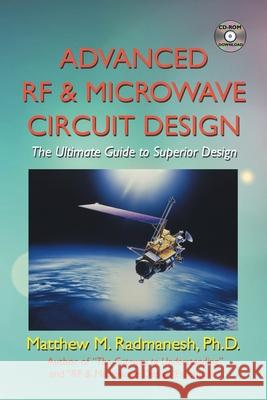Advanced RF & Microwave Circuit Design: The Ultimate Guide to Superior Design » książka
Advanced RF & Microwave Circuit Design: The Ultimate Guide to Superior Design
ISBN-13: 9781425972431 / Angielski / Miękka / 2009 / 740 str.
Advanced RF & Microwave Circuit Design: The Ultimate Guide to Superior Design
ISBN-13: 9781425972431 / Angielski / Miękka / 2009 / 740 str.
(netto: 183,56 VAT: 5%)
Najniższa cena z 30 dni: 179,79 zł
ok. 13-18 dni roboczych
Dostawa przed świętami

Darmowa dostawa!
RF and Microwaves is currently in the forefront as a fundamental technology in numerous industrial and commercial applications. As applications of RF and microwaves continue to evolve and as this technology becomes a common factor in the scientific and engineering communities it is imperative that university students and practicing scientists and engineers become thoroughly familiar with the measurement principles, electronics, and design fundamentals underlying this technology. RF and Microwaves is currently in the forefront as a fundamental technology in numerous industrial and commercial applications. As applications of RF and microwaves continue to evolve and as this technology becomes a common factor in the scientific and engineering communities it is imperative that university students and practicing scientists and engineers become thoroughly familiar with the measurement principles, electronics, and design fundamentals underlying this technology. Advanced RF & Microwave Circuit Design is the quickest way to master this powerful subject, and information contained within the pages of this book will make every key electronic, measurement, and design principle you need a simple task. The book introduces concepts on a wide range of materials and has several advantages over existing texts, including: 1. The presentation of a series of scientific postulates and axioms, which lays the foundation for any of the engineering sciences and is unique to this book compared with similar RF and Microwave texts. 2. The presentation of classical laws and principles of electricity and magnetism, all inter-related, conceptually and graphically. 3. There is a shift of emphasis from rigorous mathematical solutions of Maxwell's equations, and instead has been aptly placed on simple yet fundamental concepts that underlie these equations. This shift of emphasis will promote a deeper understanding of the electronics, particularly at RF/Microwave frequencies. 4. Fundamentals of electronics have been amply treated, which makes an easy transition to RF/Microwave principles and prevents a gap of knowledge in the reader's mind.











